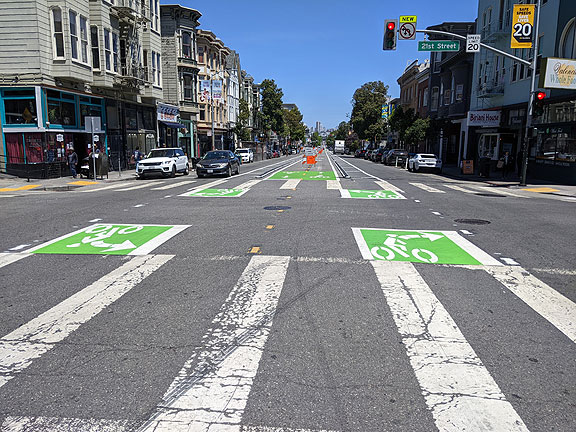
The disastrous new center bike lane on Valencia Street.
San Francisco street engineers have begun implementing what the world’s best-known bicycling diplomat, Copenhagenize’s Mikael Colville-Anderson, called the “worst infrastructure I have ever seen anywhere in the world.” The new center-of-the-street two-way cycle path on Valencia from 23rd to 15th is a disaster. It was only supported by 18% of cyclists in surveys conducted by the SFMTA months ago, and was objected to by well over 70% of respondents.
I’ve been out there riding on it a half dozen times already, even though it’s officially closed. Hundreds of other cyclists have been doing the same since the old bike lanes have been removed. As the Mission Local article documented, there’s already been a number of accidents, and at least a couple of cyclists have been hospitalized after trying to leave or enter the absurd center lanes.
So why are they doing this? Why move the once hugely popular Valencia bike lanes from the sides to the center when an overwhelming number of local cyclists opposed it? Who benefits from this? How many more will be hurt or killed before they undo this?
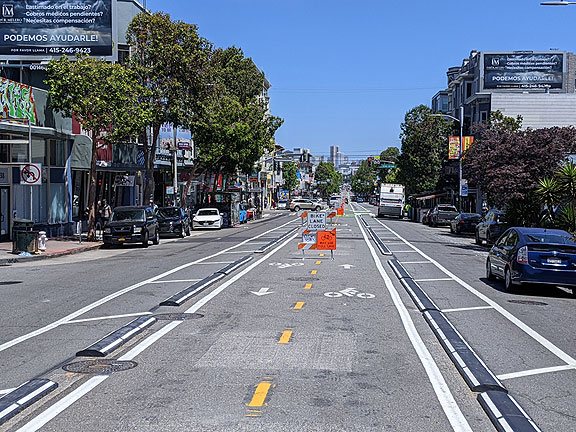
Another view with the rubber “protective” pieces installed. Soft posts to come.
It’s true that the bike lanes along the sides have been largely wrecked by endless double-parking, especially though not exclusively by Uber and Lyft drivers. It’s been incredibly irritating that the out-of-town clueless rideshare drivers have been allowed to stop wherever they want, wherever someone clutching a cell phone randomly called for a ride. How difficult would it have been for the city to create organized drop-off and pick-up spaces near the corners of each block to accommodate this?
During the last few years before the pandemic, Valencia Street had become an awful street to bicycle on. Double parking, random U-turns anywhere and anytime, cars weaving in and out of the bike lanes while drivers stared at their phones, and so on. I can only imagine this all becoming worse with the new center lanes. Cars will ignore the low rubber separators but bicycles will have a hard time leaving the center lane mid-block. In fact, bicycles will have a hard time leaving the center lane anywhere! Because the ridiculous diagonal entry and exits at 23rd (and 15th eventually) are completely unfamiliar to everyone. Neither cyclists nor motorists will know how to behave or what to expect and it’s a certainty that there will be a great number of needless collisions when drivers and cyclists take their right of way at the same time.
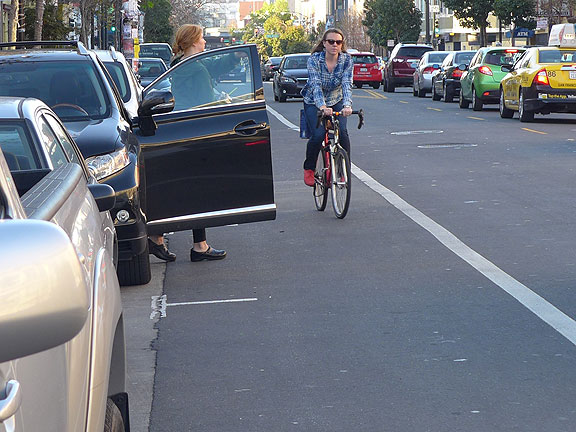
The original configuration, seen here in 2015. Dooring always a possibility.
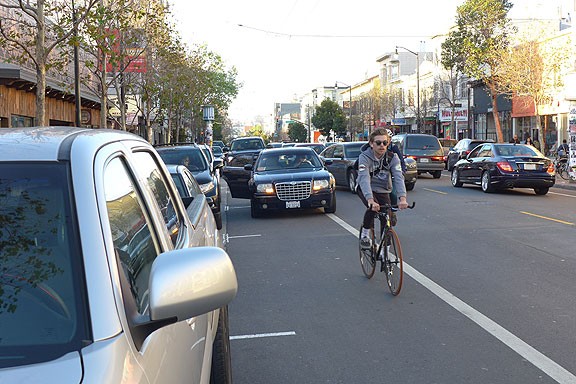
This was a typical weekday in 2015 with endless double parking of cars forcing cyclists in and out of the bike lane.
For all the merchants used to having cyclists pull up to their establishments with ease, they will now see most people opt to pass them by because of the inconvenience of stopping once you enter the center lane. I’m glad to see former metered parking eliminated in favor of loading zones and 5-minute limit pickup and dropoff zones as part of the street reconfiguration. Finally. But taken together, restricted parking and difficult access for cyclists, it may lead to worse business conditions along the once thriving corridor.
Motorists are sure to complain loudly about the restricted parking on Valencia, but the reality is that San Francisco is overflowing with parking. In Henry Grabar’s very informative and entertaining new book Paved Paradise: How Parking Explains the World, he details the remarkable numbers. “By square footage, there is more housing for each car in the United States than there is housing for each person.” In San Francisco there are 441,541 curb spaces, more than one for every household. In the Bay Area, there are 15 million parking spots, 2.4 for each car.
But overall, the reconfigured Valencia Street is an obvious failure before it’s even fully implemented. Turns out, beyond the specifics of this odd design, the issues have been with us much longer. Back in the 1890s about one in five San Franciscans were regular bicyclists, a higher rate than today’s. And just like today, the mainstream advocates of cycling were endlessly frustrated with the so-called misbehavior of some cyclists:
At a conference on municipal improvements in 1897, one speaker declared that “the greatest enemy to the cyclist in moulding public opinion, is the scorcher, whose sins are visited on all wheelmen, and they are held responsible for his misdemeanors. . .” Their actions, at least theoretically, threatened to endanger the reputation of cyclists as a whole.
p. 53, The Cycling City: Bicycles and Urban America in the 1890s by Evan Friss, University of Chicago Press: 2015

Image of “Good Roads” demonstration by bicyclists in San Francisco, 1896.
Complaints about the lack of perfect personal behavior on the part of cyclists wouldn’t be so bad if it didn’t perpetually fuel the bizarre animosity non-cyclists direct to bicyclists. In Jody Rosen’s entertaining Two Wheels Good: The History and Mystery of the Bicycle, he cites a study that concluded that 49 percent of non-cyclists regard cyclists as “less than fully human.” As someone who has been cycling in San Francisco and many other world cities over the past four decades, I can confirm that this is indeed the attitude of all too many people behind the wheel of their cars. But anytime a cyclist has tried to say this, either in opinion columns or in the comments section of numerous online publications, they are soon swamped by the angry retorts of motorists or elderly pedestrians who are sure that cyclists are the real criminals on the road. But it’s the transportation system, distorted to emphasize private automobiles by decades of lobbying and outright manipulation of government subsidies, that is the source of the problem. We won’t fix it by tinkering along the edges of various streets, as long as we continue to put the car at the center of everything. John Stehlin in his brilliant book Cyclescapes of the Unequal City: Bicycle Infrastructure and Uneven Development (University of Minnesota Press: 2019), says it well:
At issue is that the collective consumption of the street is mediated through vehicles. While there is a tendency to view mass transit as “public” and automobility as “private,” vast public subsidies go into the making of streets with specific affordance that prioritize automobiles. (p. 89)
Jody Rosen repeats an argument many of us have been making for decades now:
The climatic effects only scratch the surface of car culture’s toll. The automotive age is an age of carnage. Globally, some 1.25 million people die in car crashes each year, an average of more than 3,400 deaths per day. Automobile accidents are the leading cause of death among young adults ages fifteen to twenty-nine worldwide. An additional twenty to thirty million people are injured or disabled each year on the world’s roads.
p. 16, Two Wheels Good
I’ve been addressing this in various ways for decades, and yet it seems that the larger culture in which I exist remains obdurate in its refusal to acknowledge this toll. Americans love to wring their hands over “terrorism” or 9-11 but refuse to acknowledge that social policy in favor of private cars as the backbone of transportation means tens of thousands of deaths every year. We choose to slaughter ten times more people than died in 9-11 every year for the fraudulent, expensive convenience of using private cars. Rosen summarizes it well describing New Yorkers (though it certainly applies to the San Francisco Bay Area just as much):
Car culture bridges New York’s political chasms. The Upper West Side liberal whose hatchback sports a THINK GLOBALLY EAT LOCALLY sticker, the Staten Island Trump supporter who flies a thin blue line flag from his roof rack—these natural foes are united by a belief in free curbside parking, by opposition to congestion pricing, and by disdain for the human gnats that buzz around on bikes. (p. 267)
Much of this has been well-covered during the past three decades since we started Critical Mass here in San Francisco. But less well explained is how the bicycling culture we emerged with and from in 1992 had become mainstreamed by the early 2000s. By the time we celebrated the 20th anniversary of Critical Mass in 2012, the wacky, transgressive, innovative, and politically radical culture that characterized bicycling had nearly completely vanished.
Part of this has an under-explored echo in the original 19th century bike boom. Evan Friss’s book on the Cycling City of the 1890s (cited above) traces the arc of frenzied interest and expansion of cycling in the middle of that decade when bicycling became extremely fashionable and trendy, only to subside and crash by the early 1900s. According to his excellent research,
With more classes of people riding and more people riding for practicality, cyclists lost their social standing. In 1901, an author said as much: cycling “has ceased to be fashionable simply because the possession of a wheel is now quite possible to everyone.” “Bicycling became unfashionable,” another writer observed in 1905, as affordability increased. [emphasis added] (p. 194) No longer a social tool or another mark of fashion, bicycles were abandoned by middle-class professionals and the urban elite in greater proportion than anyone else. The bicycle then became conceived of as a vehicle for the working class. Workers might have continued to cycle to the factory, but no one would seriously consider promenading on one’s bicycle. (p. 195)
In a curious parallel, San Francisco cycling culture shriveled up in the mid-2000s and shrank continuously after that in almost direct proportion to the huge expansion of cycling infrastructure and a substantial increase in daily cycling. As people began to use bicycles as a convenient and easy way to get from A to B (Mikael Colville-Andersen’s favorite yardstick of bike use), far fewer people identified as “bicyclists.” As I’ve said a number of times in the last few years, why would anyone identify as a “bicyclist” just because they use a bike as part of their transportation mix? Why would anyone define themselves that way, any more than they might characterize themselves as a “microwavist” or a “hammer-ist” for using those tools? And yet, back in the 1980s and 1990s, it was a mark of distinction to be a bicyclist—to the point that many people became irritated by the self-righteousness in which many cyclists wrapped themselves.
John Stehlin’s book came out just before the pandemic offers a deeper and more thoughtful analysis of this evolution. Stehlin, who once worked at San Francisco’s collective bikeshop Boxdog Bikes on 14th Street, and with whom I shared a number of conversations during the years he was doing his research, reworked his Ph.D. thesis into Cyclescapes of the Unequal City: Bicycle Infrastructure and Uneven Development. Helpfully, in the preface Stehlin reminds us that the 1991 Intermodal Surface Transportation Efficiency Act (commonly referred to as ISTEA or Ice-Tea) signed into law by Bush Sr., provided $13 billion, a huge amount of money (though only about 1% of total transportation spending) that ultimately funded some 36,000 bicycle and pedestrian projects around the U.S. over the years since.Even though he spends a good deal of his book detailing the various ways that bicycling and bicycle advocacy was integrated into a new urbanist agenda that went hand-in-glove with the gentrification and the reclaiming of inner cities by Capital, he also freely admits that the “bicycle is dwarfed by the scale of the processes with which it is entangled.” (p. 187) Earlier he concedes that within the widespread political-economic restructuring in urban America that has reshaped neighborhoods and streetscapes, “bicycling is in fact quite marginal.”
Because bicycle infrastructure is relatively inexpensive and produces quick results in built-out urban environments,
the progressive politics of nonmotorized mobility align[ed] with more forward-looking factions of capital seeking a long-term “spatial fix” and a renewed competitive advantage rooted in a more livable public realm, a more prosperous city, and a more sustainable material base. This regional restructuring, promoting both concentrated investment in centrally located tech clusters and increasing suburbanization of low- and middle-wage employment, unevenly shapes the possibilities for accessing work without the means of a private automobile. (p. 20)
Stehlin continuously reorients our view away from the middle-class cyclists who fill the Mission District in San Francisco, or comparable districts in other urban areas, and towards the ubiquitous but invisible cyclists who are the real majority of daily cyclists in the U.S.
Who are the food deliverers, day laborers, dishwashers, and recycling collectors, disproportionately people of color commuting and working by bicycle, if not cyclists? Who are the veteran bicycle messengers, many of them people of color, whose aesthetic roots lie with West Indian immigrants in 1980s New York, if not cyclists? Who are the middle-class people of color and working-class whites alike who ride bikes, if not cyclists? In other words, how could a practice so manifestly diverse be understood in such a limited way? I argue that this is more than just an ideological trick but is rooted in geographical political economy. (p. xix)
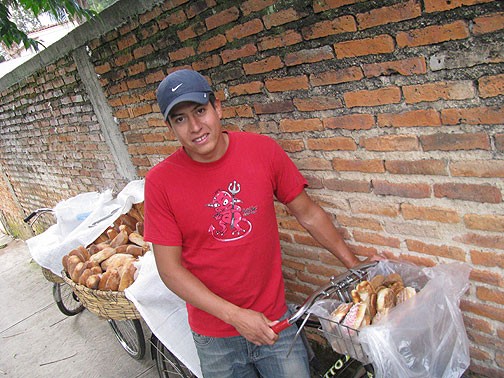
Bici Panadero in Guadalajara in 2009.
Interestingly his analysis predates the pandemic and thus may have become historically specific. He was certainly correct in seeing that the “city has emerged as the ideological center of gravity… [which] forcefully intertwined progressive efforts to create better use-values with efforts by city leaders and capital alike to revive urban exchange-values.”
How would this framework apply to the current redesign of Valencia Street? It seems to fly in the face of both interests, neither making it more pleasant to use, nor is it likely to increase the market transactions that business craves.
But overall Stehlin is sharp in his analysis of the forces, both centrifugal and centripetal, that were remaking the regional economy in the Bay Area prior to the pandemic. In my last post I wrote about Alex Schafran’s excellent Road to Resegregation, which dovetails with Stehlin’s analysis, describing how communities of color in San Francisco, Oakland, and Berkeley have been moving to the suburbs along the northern edge of Contra Costa County in Martinez, Antioch, etc. This reshuffling of where people live tends to obscure the ways which infrastructural spending benefits whiteness—Black and Latino suburban dwellers find themselves more car-dependent than ever, while the new high-wage workers of the central city are provided with the latest in dedicated, separated bikeways. The progressive demand for livability brings improvement to the walkability and bike-ability of city streets, which is good for the parts of Capital that depend on the high-tech, high-wage workforce that prefers dense urban living. But the folks who have finally escaped to the suburbs are held as somehow complicit in a climate-hostile lifestyle that was put in place during the past decades of car (and white) supremacy.
Back to Valencia Street, Stehlin, who knew it well when he lived here, declares that
Valencia Street highlights the transformation of the relationship between the politics of mobility and post-Fordist urban capitalism, in which qualities of place rather than capacity for traffic flow have become a city’s most valuable asset. . . … Valencia was the central axis of the Mission’s “dot-com fever.” . . . few people involved in bicycle advocacy at the time anticipated the extent of the gentrification the next few years would see. Still less was it conceivable that bicycle infrastructure could be related to the changes. . . . The most visible commercial changes concentrated on Valencia Street. Through the first decade of the century, Valencia changed from a working-class light-industrial corridor with a Latino character and a strong punk and lesbian subculture to the spine of one of the most rapidly gentrifying areas in the Bay Area lined with chic cafes, boutiques, restaurants, and bars that reflected deep demographic shifts in the neighborhood. (p. 87-97)
Actually the demise of the punk and lesbian corridor was well underway by the mid-1980s and long predates the dotcom boom of the later 1990s. But the transformation from a working-class shopping area with car repair shops, funeral parlors, light industry (including Pepsi-Cola bottling where the police station is now) did happen, starting with the punk and lesbian scene in the late 1970s, with a half dozen bookstores, and eventually turning into the bar-, restaurant-, and boutique-laden corridor it became as the money arrived. When the first bike lanes went in in the 1990s and Valencia was put on a road diet (one lane each way, rather than the previous two), it was a fantastic improvement. It was clear that it would not have happened without the mass seizure of the streets by Critical Mass on the last Friday of every month for years.
But what we didn’t understand well was that these improvements would trigger a commercial success surprise that became used as the “Valencia model” by new urbanists and progressive planners nationwide.
Claiming the value of cyclists for localized patterns of neighborhood growth, on Valencia Street, Telegraph Avenue, or International Boulevard . . . present[s] certain cyclists as key economic actors [that] makes the neighborhoods they shape legible as investable spaces. (p. 138) . . . What appears self-evident now to both advocates and city officials—that bicyclists signal economic vitality—was in fact made through a discursive and material process to which gentrification was critical. In essence, it was not the aggrieved poor but the rising middle classes who mobilized around this wave of federal spending. Therefore the entanglement of bicycle advocacy with gentrification did not simply happen because middle-class and professional whites moved to disinvested urban cores and began bicycling. But as gentrification has accelerated, due mainly to forces beyond the bicycle, the framing of bicycle infrastructure as an economic development strategy has become increasingly persuasive, and cities now act upon this narrative in ways that do contribute to gentrification. (p. 139)
Stehlin does a great job of describing how bicycling got a “reputation rehab,” thanks to bicycle advocates who positioned it as good for business during the past two decades. He argues that “the political settlement over bicycle infrastructure emerged from a struggle between the countercultural Left, the SF Bike Coalition (SFBC), and the municipal bureaucracy, in which advocates [became] ‘expert-citizens.’” (p. 118) I guess I was part of that ‘countercultural Left’ and I definitely watched with dismay as the SFBC became more hierarchical and “normal” as a nonprofit NGO who wanted a seat at the table of municipal governance, and tried to put the lid on grassroots activism that wasn’t formally approved by its executive director and board of directors. By the 2012 20th anniversary of Critical Mass, the SFBC couldn’t even acknowledge that the (10,000-strong) ride was happening, instead using the calendar in their printed newsletter to encourage its members to help with valet bike parking at a local museum.
Today’s Valencia Street is a direct product of the tepid politics of the SFBC. I remember attending a public meeting in the Chapel (it was New College then) in the mid-1990s run by Deep (a longtime SFBC Board member who lives on Valencia and works for Apple). We were discussing plans for the bike lanes on Valencia and I piped up to say that the painted stripes were lame and we should be fighting for separated bike lanes with their own elevated pavement between parked cars on the street and the sidewalk. Deep shushed me and insisted that such a proposal was entirely unrealistic and we couldn’t even discuss it.
Years later I ran into Leah Shahum, longtime ED of the SFBC during its move towards political acceptability, after her extended vacation in Europe which included a stint in Holland. She admitted that they had “blown it” on Valencia and should have pursued separate bikeways back then. Sidewalk widening and bulb-outs were implemented during a later street makeover in the early 2010s, and during the pandemic numerous new parklets and restaurant booths were installed. The bike lanes were overrun for most of the decade by double-parking motorists. Now they’re putting the cyclists in the middle of the street, almost like an expressway for cycling.
Rethinking and redoing the whole street from 15th to 24th or all the way to Mission, is the only appropriate response. Let’s convert Valencia to one lane of one-way traffic going north to south, putting pickup and dropoff zones for three car lengths at each corner from 16th to 24th. Loading zones and some metered parking on each block can also be accommodated if we get rid of an entire lane of car traffic in favor of a two-way bikeway with its own elevated pavement and curb next to the opposite sidewalk. Ample bike parking corrals should also be included on each block. As soon as possible, ban cars entirely on the blocks from 16th to 22nd during evenings from 6-10 pm, eventually leading to a permanent pedestrian and bikeable mall on some or all of that stretch of Valencia.
But none of this addresses the missing question for bicyclists that I raised a few times in speeches at World Bike Forums in South America: If bicycling is the key, what does it unlock? It’s fine to move by bike from point A to point B, certainly preferable to other modes of transit. But what the hell are we doing at point A and point B? We have to rethink and reconfigure much more than how we move around the city. We have to stop doing a great deal of the stupid work we do, and start doing a huge number of things that we haven’t even begun yet. For example, replumbing every home in the city to stop pooping in drinking water! Preparing ourselves for the inevitable return of years-long drought conditions. Creating robust and resilient locally produced electricity with the solar and wind capacity that exists within the city itself, and breaking with the profit-making inefficiency and corruption of PG&E once and for all. Deconstructing empty buildings that sit on land that could be better used as flood zones for the inevitable encroachment of seawater. Creating a dynamic network of neighborhood news organizations that produce websites and newspapers that employ journalists and writers and keep us informed! An intense program to convert buildings to social housing until everyone has a decent place to live and the resources to maintain it. And on and on… None of this will be done, or can be done by a growth-obsessed economy dedicated to accumulating capital over all other measures of human well-being. Obviously.












I also didn’t see any typos or errant punctuation, or misspelled (that word always seems misspelled to me). I’m only familiar with the bike situation in rural Connecticut, or Boston (taking your life in your hands) but the center lane to me seems pretty wonky.
Hey Chris, appreciate your writing and breadth of thoughts, and offer these thoughts: 1) The city prefers curb side bikeways. We even put them in on Valencia between Market and 15th St just before the pandemic. The same curbside design was not extended south due to a number of issues. We’re not putting a two-way down the middle of the road for fun or some academic exercise. 2) The design you mention (the two-way design aka Burrito Justice plan or some variation) would have been great to try but would not work given the existing signals and the need to keep 26′ clear for SFFD (going one-way with one lane is too narrow for their needs) 3) Mikael Colville-Anderson thinks any bikeway design that is not one-way on each side of the road along the curb is junk. I’ve heard him deride two-way bikeways so many times. The irony of quoting him in criticizing the current plan is that he would say the preferred two-way bikeway design on one side of the street you describe is a bad design. 4) This unusual design is being done as a pilot to see if it works. Other designs would be great to try but again we are limited in what we can do in the near term due to existing infrastructure that would take years to adjust.
Indeed, I had typing class throughout my 9th grade at Claremont Junior High in Oakland. And my early work experiences were mostly as a word processor/secretary/receptionist… then I got a typesetting machine in 1980 which had an unforgiving 256k memory, so every line I typed printed immediately on photo paper inside. Typos had to be retyped and then carefully cut out of waxed paper and pasted over the errant line… a very strong pavlovian training in accurate typing! Still, I’m glad you didn’t see it until I repaired several typos… and thanks as always for being my most reliable reader and commenter! I DO appreciate it!
Brilliant reporting – like a New York Review of Books or London Review of Books extended essay, but from an actual on-the-ground expert and intellectual. Should be in in one of the Best American Essays 2023-type compilations.
I also really like the last two sentences, which should be worrying, though, for those of your readers who are staunch Activos.
One procedural question – did you, in your working careers, acquire top-notch typing skills? There’s not a misspelled word or missing word anywhere. I, on the other hand, never learned to type other than clumsily.